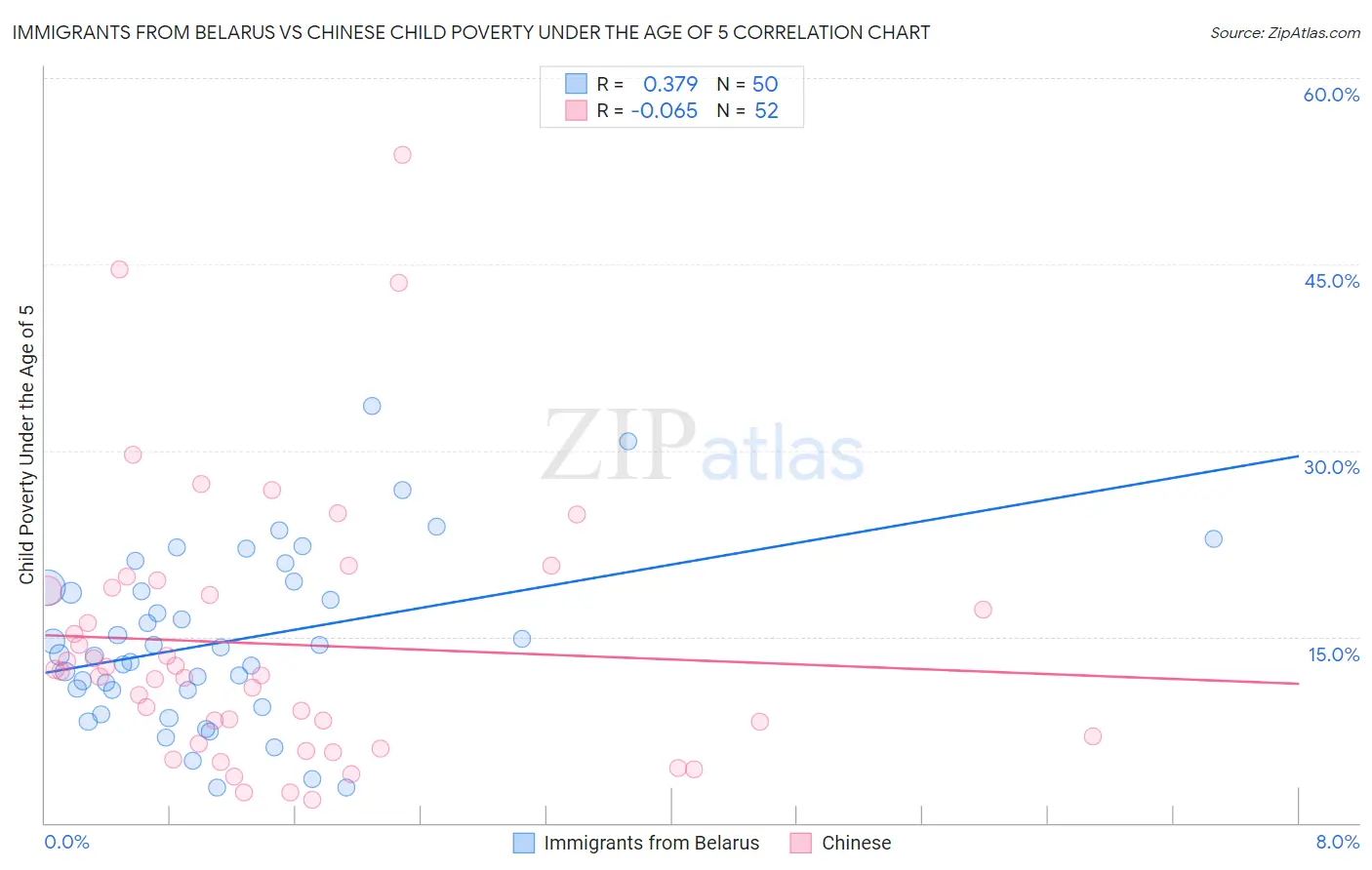Immigrants from Belarus vs Chinese Child Poverty Under the Age of 5
COMPARE
Immigrants from Belarus
Chinese
Child Poverty Under the Age of 5
Child Poverty Under the Age of 5 Comparison
Immigrants from Belarus
Chinese
14.7%
CHILD POVERTY UNDER THE AGE OF 5
99.7/ 100
METRIC RATING
41st/ 347
METRIC RANK
13.1%
CHILD POVERTY UNDER THE AGE OF 5
100.0/ 100
METRIC RATING
7th/ 347
METRIC RANK
Immigrants from Belarus vs Chinese Child Poverty Under the Age of 5 Correlation Chart
The statistical analysis conducted on geographies consisting of 145,813,526 people shows a mild positive correlation between the proportion of Immigrants from Belarus and poverty level among children under the age of 5 in the United States with a correlation coefficient (R) of 0.379 and weighted average of 14.7%. Similarly, the statistical analysis conducted on geographies consisting of 64,186,861 people shows a slight negative correlation between the proportion of Chinese and poverty level among children under the age of 5 in the United States with a correlation coefficient (R) of -0.065 and weighted average of 13.1%, a difference of 12.2%.

Child Poverty Under the Age of 5 Correlation Summary
| Measurement | Immigrants from Belarus | Chinese |
| Minimum | 2.8% | 1.9% |
| Maximum | 33.6% | 53.8% |
| Range | 30.8% | 52.0% |
| Mean | 14.7% | 14.4% |
| Median | 13.8% | 12.1% |
| Interquartile 25% (IQ1) | 10.7% | 6.7% |
| Interquartile 75% (IQ3) | 18.9% | 18.8% |
| Interquartile Range (IQR) | 8.3% | 12.1% |
| Standard Deviation (Sample) | 6.9% | 10.8% |
| Standard Deviation (Population) | 6.8% | 10.7% |
Similar Demographics by Child Poverty Under the Age of 5
Demographics Similar to Immigrants from Belarus by Child Poverty Under the Age of 5
In terms of child poverty under the age of 5, the demographic groups most similar to Immigrants from Belarus are Immigrants from Australia (14.6%, a difference of 0.12%), Soviet Union (14.7%, a difference of 0.16%), Immigrants from Greece (14.7%, a difference of 0.16%), Immigrants from Philippines (14.7%, a difference of 0.29%), and Eastern European (14.6%, a difference of 0.41%).
| Demographics | Rating | Rank | Child Poverty Under the Age of 5 |
| Immigrants | Moldova | 99.8 /100 | #34 | Exceptional 14.5% |
| Latvians | 99.8 /100 | #35 | Exceptional 14.5% |
| Maltese | 99.8 /100 | #36 | Exceptional 14.5% |
| Turks | 99.7 /100 | #37 | Exceptional 14.6% |
| Eastern Europeans | 99.7 /100 | #38 | Exceptional 14.6% |
| Norwegians | 99.7 /100 | #39 | Exceptional 14.6% |
| Immigrants | Australia | 99.7 /100 | #40 | Exceptional 14.6% |
| Immigrants | Belarus | 99.7 /100 | #41 | Exceptional 14.7% |
| Soviet Union | 99.7 /100 | #42 | Exceptional 14.7% |
| Immigrants | Greece | 99.7 /100 | #43 | Exceptional 14.7% |
| Immigrants | Philippines | 99.7 /100 | #44 | Exceptional 14.7% |
| Laotians | 99.6 /100 | #45 | Exceptional 14.7% |
| Tsimshian | 99.6 /100 | #46 | Exceptional 14.7% |
| Russians | 99.6 /100 | #47 | Exceptional 14.8% |
| Immigrants | Czechoslovakia | 99.6 /100 | #48 | Exceptional 14.8% |
Demographics Similar to Chinese by Child Poverty Under the Age of 5
In terms of child poverty under the age of 5, the demographic groups most similar to Chinese are Iranian (13.1%, a difference of 0.020%), Immigrants from Iran (13.1%, a difference of 0.17%), Immigrants from Singapore (12.9%, a difference of 0.98%), Burmese (13.2%, a difference of 1.3%), and Immigrants from Korea (13.2%, a difference of 1.4%).
| Demographics | Rating | Rank | Child Poverty Under the Age of 5 |
| Immigrants | India | 100.0 /100 | #1 | Exceptional 11.5% |
| Immigrants | Taiwan | 100.0 /100 | #2 | Exceptional 11.6% |
| Filipinos | 100.0 /100 | #3 | Exceptional 11.6% |
| Thais | 100.0 /100 | #4 | Exceptional 12.3% |
| Immigrants | Hong Kong | 100.0 /100 | #5 | Exceptional 12.4% |
| Immigrants | Singapore | 100.0 /100 | #6 | Exceptional 12.9% |
| Chinese | 100.0 /100 | #7 | Exceptional 13.1% |
| Iranians | 100.0 /100 | #8 | Exceptional 13.1% |
| Immigrants | Iran | 100.0 /100 | #9 | Exceptional 13.1% |
| Burmese | 100.0 /100 | #10 | Exceptional 13.2% |
| Immigrants | Korea | 100.0 /100 | #11 | Exceptional 13.2% |
| Immigrants | South Central Asia | 100.0 /100 | #12 | Exceptional 13.3% |
| Bhutanese | 100.0 /100 | #13 | Exceptional 13.4% |
| Okinawans | 100.0 /100 | #14 | Exceptional 13.4% |
| Indians (Asian) | 100.0 /100 | #15 | Exceptional 13.4% |